“Trees are
invitations to think about time and to travel in it the way they do, by
standing still and reaching out, and down,” wrote Rebecca Solnit[ii].
Most of us have had “ah-hah!” experiences in life – seeing the Northern
Lights for the first time, standing beneath a giant Redwood, or sitting with a
dying friend, to name a few.
When I entered the sanctuary of Peace Church (UCC) in Duluth, MN for the first time, I was overcome with a similar feeling. I felt strangely “at home” here - as if I had been here all of my life. It was as if my evangelical past and my progressive present were coming together in new ways. I was immediately impressed by the congregation’s choice of two striking works of art to guide their meditations. Jesus of the People by my friend, Janet McKenzie, hangs prominently in its worship space. Janet had used a Black female model for this Jesus. For that audacity she won the National Catholic Reporter’s worldwide art competition in the year 2000.
More surprisingly for this decidedly Protestant congregation was a copy of the iconic Our Lady of Guadalupe, said to have appeared miraculously on Juan Diego's original tilma. I doubt that one can find either in the sanctuary of any other UCC congregation in America.
As I walked toward three large crosses that dominate the front wall, and toward the Table and these pictures, I felt physically pulled toward the right side of the sanctuary. In that moment, I saw Leah Yellowbird’s painting, The Tree of Life. I would like to say it called to me, but that would be wrong. It screamed at me. “Come here!” it demanded. I did. And I wept.
Leah Yellowbird[iii] identifies strongly with her First Nations Algonquin-Metis and Anishinaabe heritage. At an early age she learned traditional beading patterns from her aunt whose influence you can see in her work today. After a difficult time in her life, she moved physically to Grand Rapids, and artistically into painting, but she retained the
precision and delicate beauty of the finest beadwork of her tradition. Today her work is displayed in museums throughout the Midwest. Her online website contains some of the most beautiful artwork you will ever want to see. The Tree of Life painting has its roots in a
period of turmoil and deep trauma, she said, but when I look at her painting, I
don’t see the suffering. “Nevertheless,” Yellowbird said to me, “if they are
honest, most artists will tell you that their art begins in trauma.”
The Tree of Life appears in many traditions around
the world. In our Christian tradition, it appears at the beginning of Time, and
at its ending, and throughout human history.
Yellowbird stresses that this is not a Christian
work of art, at least not explicitly or literally so. Notice, she points out,
that this Tree stands on the back of a turtle, Turtle Island.
Robin Wall Kimmerer, among others, tells the Haudenosaunee
creation story this way:
At one time humans lived in the Sky world. At its
center stood the Tree of Life. One day a fierce wind blew through the heavens.
It toppled this great tree. Where the tree once stood, there was a hole.
A young woman, Gizhgokwe (who also is called Skywoman), walked over to the hole and peered
down. She saw only a deep, dark blackness. She came closer to the hole. And closer. The soil beneath her feet began to crumble, and she started to fall into the darkness. Quickly, she grabbed a branch from the Tree of Life, but it broke off in her hand. Into the abyss she fell.[iv] But it was not an abyss. At the bottom, there was
water. Nothing but water. For as far as anyone could see, water, and water
dwelling creatures.
A flock of geese saw her falling. Knowing she was not a
water creature, they flew up and caught her in their wings. She found herself
sheltered in the soft feathers of the geese.
A great ridge back snapping turtle swam slowly
beneath Gizhgokwe and offered its back. The geese brought her gently down upon
the back of the turtle.
All the sea creatures understood that this was not
enough. She would need earth. They remembered that there is mud at the bottom
of the sea. One by one they tried to retrieve it, but all of them failed.
Finally, a little muskrat descended into the depths where, unfortunately, it
died. When its body rose to the surface, they found a small dollop of mud in
its paw.



















